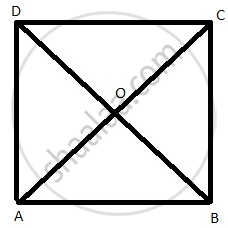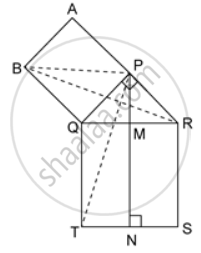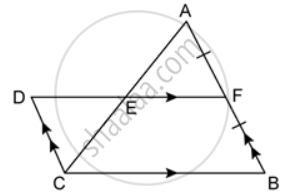Advertisements
Advertisements
प्रश्न
In a quadrilateral ABCD, AB = AD and CB = CD.
Prove that:
- AC bisects angle BAD.
- AC is the perpendicular bisector of BD.
उत्तर
Given: ABCD is quadrilateral,
AB = AD
CB = CD
To prove:
- AC bisects angle BAD.
- AC is the perpendicular bisector of BD.

Proof:
In ΔABC and ΔADC,
AB = AD ...(given)
CB = CD ...(given)
AC = AC ...(Common side)
ΔABC ≅ ΔADC ...(SSS)
∠BAD = ∠DAO ...(AC bisects A)
Therefore, AC bisects ∠BAD
OD = OB
OA = OC ...(diagonals bisect each other at O)
Thus, AC is perpendicular bisector of BD.
Hence, proved.
APPEARS IN
संबंधित प्रश्न
All squares are rhombuses and also rectangles.
All squares are not parallelograms.
Identify all the quadrilaterals that have four right angles
Explain how a square is a quadrilateral
Explain how a square is a rhombus.
ABCD is a square. A is joined to a point P on BC and D is joined to a point Q on AB. If AP = DQ;
prove that AP and DQ are perpendicular to each other.
Prove that the quadrilateral formed by joining the mid-points of a square is also a square.
In the given figure, ΔPQR is right-angled at P. PABQ and QRST are squares on the side PQ and hypotenuse QR. If PN ⊥ TS, show that:
(a) ΔQRB ≅ ΔPQT
(b) Area of square PABQ = area of rectangle QTNM.
In the given figure AF = BF and DCBF is a parallelogram. If the area of ΔABC is 30 square units, find the area of the parallelogram DCBF.
In a parallelogram PQRS, M and N are the midpoints of the sides PQ and PS respectively. If area of ΔPMN is 20 square units, find the area of the parallelogram PQRS.
